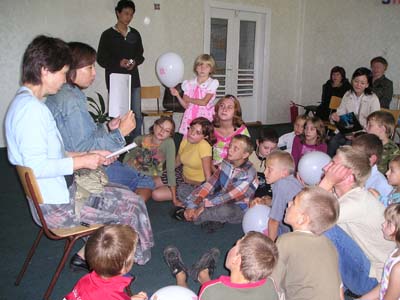 |
| Reading Japanese children's stories at a care center in Belarus |
Kansai Relief for Chernobyl Hibakusha1 was formed in 1991, five years after the Chernobyl accident and in the same year that a tube ruptured in the steam generator of Kansai Electric's Mihama-1 reactor. We are a grass roots citizens' network united by the belief that we cannot remain silent while people, especially children, are being exposed to radiation, and that Chernobyl must not be repeated in Japan.
Each year for the past 15 years we have visited contaminated regions in the state of Mogilev in Belarus to support and engage with the Chernobyl hibakusha. We have provided material support (such as medicine, medical equipment, baby food and financial assistance for kindergartens and schools), as well as mental and emotional support for people in the disaster area. By building relationships face to face and by feeling both the physical and mental suffering of the people like family members, or as close friends, we have come to know in a much more real way the impact of the accident on people's health and on their lives, on society and on the environment. Also, every few years we have invited victims' representatives to Japan and taken them to Hiroshima and to Fukui Prefecture, where several nuclear power plants are located. At the same time as raising funds, we have used the opportunity to raise awareness of Chernobyl within the Japanese anti-nuclear energy movement.
Sixty one years ago, Japan experienced the atomic bombings of Hiroshima and Nagasaki. Since then, the damage to the health of the Hiroshima and Nagasaki hibakusha, including cancer and leukemia, increased general illness, and numerous other symptoms, has become more and more clear. The social and historical context and the circumstances of the radiation exposure in the cases of Hiroshima and Nagasaki were different from Chernobyl, but in the twenty years since the Chernobyl accident, the same health damage has been seen and it is expected that this will become more and more evident as time goes by. They also share other common problems, such as the destruction of people's livelihood, social discrimination, deliberate underestimation of the damage caused by the radiation by governments which wish to promote nuclear energy, and lack of access to state support. These are problems faced by all types of hibakusha. We link Hiroshima, Nagasaki and Chernobyl and learn from the experiences of all types of nuclear victims, be they victims of nuclear weapons, or of nuclear energy. We hope to continue to work with young people with the aim of creating a world without nuclear victims.
Twenty years since the accident, "Chernobyl" is by no means over. People continue to face numerous problems caused by such things as radioactive pollution, health damage, collapse of the local economy, lack of access to government support, etc., etc.. Also, Chernobyl continues to raise new problems, such as chronic exposure to low levels of radiation and the impact on the health of future generations. We cannot accept the underestimation of the effect of exposure to radiation from Chernobyl by the IAEA and others. They ignore the real situation for the purpose of promoting nuclear energy.
Sloppy management, which places profits first, has led to fatal accidents at nuclear power plants in Japan. Despite frequent earthquakes, criticism of the earthquake safety guidelines and a court decision requiring the suspension of operations of a nuclear reactor, the government and the utilities continue to operate nuclear power plants. There is no guarantee that a major accident like Chernobyl will not occur in Japan. The Chernobyl accident continues to raise the alarm for us in Japan. With the Chernobyl hibakusha we say, "No more Chernobyls." We also say, "Stop nuclear power plants!" and "Stop the nuclear fuel cycle!"
1. Hibakusha is a Japanese word meaning nuclear victims. It was originally used to refer to victims of nuclear weapons, but has been extended to refer to any victims of atomic radiation. The term is now used worldwide. We included this word in our group's name because we refuse to accept either nuclear weapons or nuclear energy. It also expresses our solidarity with the struggle of all nuclear victims.
* Katsumi Furitsu is a doctor and member of Kansai Relief for Chernobyl Hibakusha. She was one of the speakers at the April 16th Chernobyl Forum.
Click here for articles about other Japanese groups
Return to NIT 112 contents

